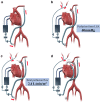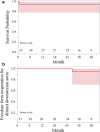Early and mid-term outcome of frozen elephant trunk using spinal cord protective perfusion strategy for acute type A aortic dissection
- PMID: 32152953
- PMCID: PMC7522075
- DOI: 10.1007/s11748-020-01328-z
Early and mid-term outcome of frozen elephant trunk using spinal cord protective perfusion strategy for acute type A aortic dissection
Abstract
Objective: This study aimed to evaluate the prevalence of spinal cord injury in total arch replacement with frozen elephant trunk for acute type A aortic dissection using our spinal cord protection technique.
Methods: Between January 2013 and December 2017, 33 patients underwent total arch replacement with frozen elephant trunk for acute type A aortic dissection (mean age 67.9 ± 13.3 years). Our spinal cord protection technique involved maintaining extracorporeal circulation through the left subclavian artery in all procedures, using aortic occlusion balloon during distal anastomosis, and inserting frozen elephant trunk above Th 8 with transesophageal echocardiographic guidance. Computed tomography was performed within 1-2 weeks, 12 months, and 36 months postoperatively. We compared the degree of thrombosis of the descending aorta between preoperation and early postoperative period by Fisher's exact test. Moreover, we evaluated postoperative mortality and mobility (including spinal cord injury) at follow-up.
Results: The operative mortality within 30 days was 6.1%. Neither paraplegia nor paraparesis was noted. We observed significant thrombosis of the false lumen at the distal arch and aortic valve level of the descending aorta in postoperative early term period (p < 0.01). At mid-term follow-up (mean 33.9 months), survival probability and 3-year freedom from reoperation rates were 93.9 ± 4.1% and 95.0 ± 4.9%, respectively.
Conclusions: The frozen elephant trunk technique with our spinal protection strategy provides good postoperative outcomes. Our strategy can maintain spinal cord perfusion without complete ischemia time even during lower body ischemia time. Implementation of our spinal protection strategy will help prevent spinal cord injury and dilated downstream aorta.
Keywords: Acute aortic dissection; Aortic balloon occlusion; Frozen elephant trunk; Spinal cord injury; Total arch replacement.
Conflict of interest statement
We have no conflict of interest.
Figures






References
-
- Kim JB, Chung CH, Moon DH, Ha GJ, Lee TY, Jung SH, et al. Total arch repair versus hemiarch repair in the management of acute DeBakey type I aortic dissection. Eur J Cardiothorac Surg. 2011;40:881–887. - PubMed
-
- Kimura N, Itoh S, Yuri K, Adachi K, Matsumoto H, Yamaguchi A, et al. Reoperation for enlargement of the distal aorta after initial surgery for acute type A aortic dissection. J Thorac Cardiovasc Surg. 2015;149(S91–8):e1. - PubMed
MeSH terms
LinkOut - more resources
Full Text Sources

